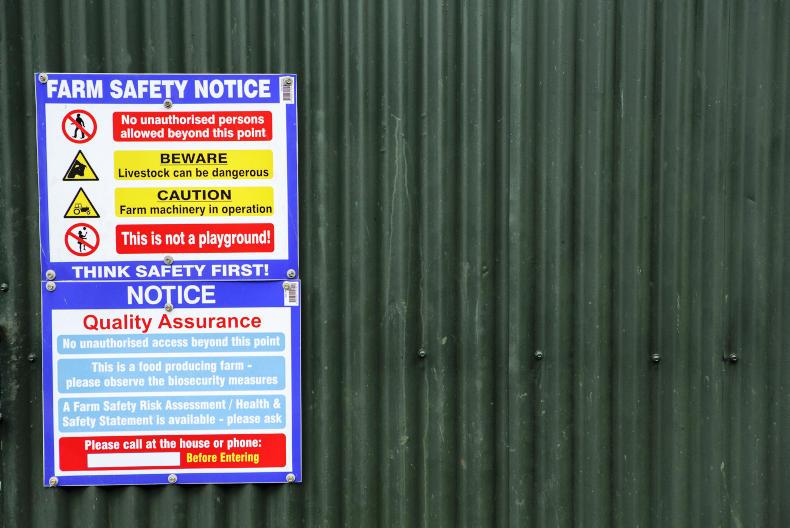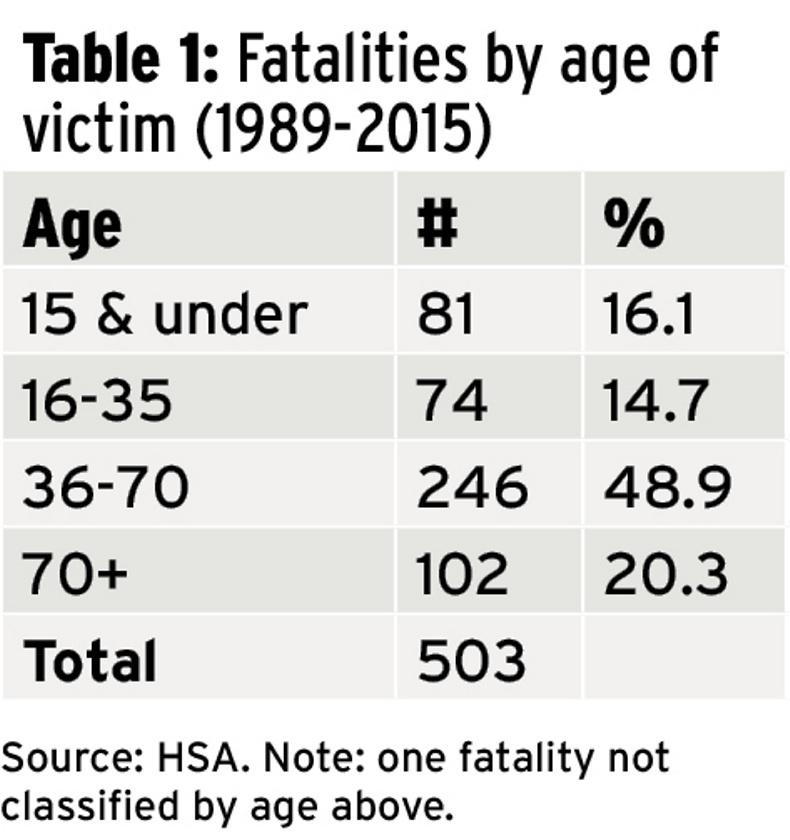According to Teagasc’s director of knowledge transfer, Prof Tom Kelly, the variety of visitors to Ireland’s 140,000 farms means that 400,000 people are exposed to the risk of farm accidents. This was one of the key messages from the national farm safety conference held in Mullingar last Friday, organised by the Farm Safety Partnership, which includes the Health and Safety Authority (HSA), Teagasc and farming organisations.
Prof Jim Phelan of the HSA, who chairs the partnership, said the diversity of people present on Irish farms was reflected in fatality statistics.
While self-employed farmers accounted for 65% of the 504 killed on farms between 1985 and 2015, the second largest group of victims was non-farm workers. Contractors were also badly hit, with more fatalities than farmers themselves in the tillage sector. Over 16% were children under 16 (see Table 1).

Both speakers said farm safety campaigners were facing a challenge in reaching those diverse groups with targeted prevention messages.
According to the HSA, farmers and farm workers are eight times more likely to die in a workplace accident than the general working population.
Phelan showed that mixed-enterprise farms accounted for the highest number of deaths, followed by beef and dairy farms. Both he and Kelly linked low incomes to higher risk, with time and financial pressure causing farmers to rush and low-profit or part-time farms less likely to see investment in safety equipment.
Listen to an interview with farm accident survivor Peter Gohery, one of the speakers at the conference:
Listen to "Farm accident survivor Peter Gohery" on Spreaker.
Phelan said “the messages should be different” for highly efficient, full-time farmers and for those making less money. With farmer behaviour involved in 90% of accidents, he said that much could be done around the message that “behaviour change doesn’t require investment”.
Kelly said the expansion of agriculture attracting new people posed a challenge to ensure they were all ready to farm safely. He also warned of difficulties in reaching “late and non-adopters” – the one in three farmers he estimated had not yet engaged in farm safety activities.
However, he saw opportunities in the 1,900 students now beginning the Green Cert, including safety training every year and the obligation to follow a risk assessment module to access schemes such as TAMS. He also said that 550 facilitators of the knowledge transfer (KT) scheme would receive safety training shortly and include it in the discussion groups.
The national farm safety conference itself was a KT-approved event and attracted more than 150 participants including farmers, safety professionals and farm representatives.
Read more
Full coverage: farm safety
According to Teagasc’s director of knowledge transfer, Prof Tom Kelly, the variety of visitors to Ireland’s 140,000 farms means that 400,000 people are exposed to the risk of farm accidents. This was one of the key messages from the national farm safety conference held in Mullingar last Friday, organised by the Farm Safety Partnership, which includes the Health and Safety Authority (HSA), Teagasc and farming organisations.
Prof Jim Phelan of the HSA, who chairs the partnership, said the diversity of people present on Irish farms was reflected in fatality statistics.
While self-employed farmers accounted for 65% of the 504 killed on farms between 1985 and 2015, the second largest group of victims was non-farm workers. Contractors were also badly hit, with more fatalities than farmers themselves in the tillage sector. Over 16% were children under 16 (see Table 1).

Both speakers said farm safety campaigners were facing a challenge in reaching those diverse groups with targeted prevention messages.
According to the HSA, farmers and farm workers are eight times more likely to die in a workplace accident than the general working population.
Phelan showed that mixed-enterprise farms accounted for the highest number of deaths, followed by beef and dairy farms. Both he and Kelly linked low incomes to higher risk, with time and financial pressure causing farmers to rush and low-profit or part-time farms less likely to see investment in safety equipment.
Listen to an interview with farm accident survivor Peter Gohery, one of the speakers at the conference:
Listen to "Farm accident survivor Peter Gohery" on Spreaker.
Phelan said “the messages should be different” for highly efficient, full-time farmers and for those making less money. With farmer behaviour involved in 90% of accidents, he said that much could be done around the message that “behaviour change doesn’t require investment”.
Kelly said the expansion of agriculture attracting new people posed a challenge to ensure they were all ready to farm safely. He also warned of difficulties in reaching “late and non-adopters” – the one in three farmers he estimated had not yet engaged in farm safety activities.
However, he saw opportunities in the 1,900 students now beginning the Green Cert, including safety training every year and the obligation to follow a risk assessment module to access schemes such as TAMS. He also said that 550 facilitators of the knowledge transfer (KT) scheme would receive safety training shortly and include it in the discussion groups.
The national farm safety conference itself was a KT-approved event and attracted more than 150 participants including farmers, safety professionals and farm representatives.
Read more
Full coverage: farm safety







 This is a subscriber-only article
This is a subscriber-only article











SHARING OPTIONS: